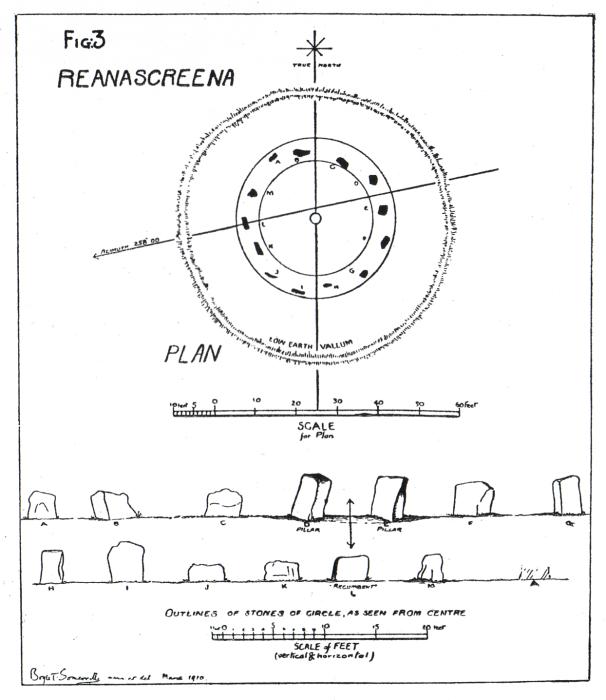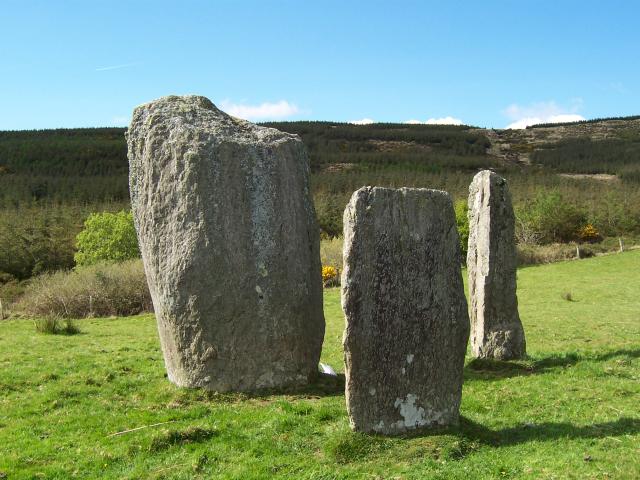





Taken from JCHAS No.35 1930.
Somerville died in 1936, murdered by a group of local eejits because he encouraged young lads to join the Royal Navy.

Looking southwest. Carrigfadda is the taller hill to the rear. Maulatanvally is to the left.

Looking North... at the forestry

As they skiff across the water, triple stones.
This fine alignment, looking like nothing so much as the plates of a submerging dinosaur, nestles on a plateau just south of the forestry on the other side of the hill from the four-poster at Lettergorman N. Lettergorman S is downhill slightly to the southwest, in the first field beyond the townland boundary.
The tallest stone, a fin-shaped pillar almost 3 metres tall, is at the northeast of the row. The middle stone is a straightforward block, and the southwesterly stone, possibly others, are obscured in a wig of dead vegetation.
The row is aligned, looking in this direction (and fairly unremarkably), on the eastern slope of the hillock of Maulatanavally. Clive Ruggles (Astronomy in Prehistoric Britain and Ireland, 1999; 220) mentions a direct alignment in the opposite direction, to a hilltop to the northeast, but the forestry wall has cut off any sight of this. The views would seem to have been extensive in all directions before the plantation.
A word of warning. Due to unbelievably sodden ground in the approach from the west in wintertime it may be wiser to come at it via the farm to the east.
“And then we emerged to see the stars again.”
Dante Alighieri, Inferno XXXIV, 139.
(Trans. C.H. Sisson, Oxford 1998)

NW into clearing

Over right portal SW to axial

To NE

NE into clearing

Walk north (straight into trees) about 45 paces at this gap.

Walk west (forward) about 120 paces from end of track here.

Turn right here off forest road

From W

From SE

From NW

From NW

From SE
Aubrey Burl, in his guide, reckons this to be an ‘outstanding site’ with ‘easy’ access. To be honest I made a bit of a mess of it myself, but it isn’t really that hard to find.
Take the road south past the circles at Kealkil and Breeny More. When you eventually reach the T-junction head east for a mile and a quarter. There should be two houses down the slope to your right, with very close parallel driveways. There will also be a bungalow on the hill to your left. You can ask for permission here.
The gateway to the four-poster is a short distance back the road to the west. Keep to the track and you should pass back above the owner’s bungalow. You will cross a small stream and see an old wall topped with holly trees.
Walk up the hill past this and you can now, hopefully, see the tip of the tallest stone.
Gortnacowly is one of just five accepted four-posters in Cork and Kerry. This category of monument was only confirmed to exist here in the last thirty years. Its fourth stone, like that at Lettergorman, is missing. (According to O’Nuaillain’s 1984 description it was still present in 1899.)
The three surviving stones are all tall, again like Lettergorman, miles and hills away to the south east. On the other hand the domination of the triangle by one huge ten foot hulk gives it an immediate visual similarity to four stoned Cappaboy Beg, a hill and valley to the north. The monolith there is at the north east of the structure, while here it stands to the south west. Apparently at Reenkilla in Kerry, which I have yet to see, there is a similar domination to the north west.
Its setting is spectacular. The Maughanaclea hills rise above it to the north east. To the east sits Nowen hill and to the south stretches wide Mullaghmesha.
The monument itself however leaves me feeling somewhat underwhelmed. Perhaps it’s the absence of the fourth stone. Even when a circle mirrors the horizon, or perhaps because a circle does so, it has an intentional impact on the landscape. With the fourth stone removed the structure seems more random and natural. Or maybe I just like things round.
PS. I’ll stick in a plan ‘after’ O’Nuallain or Burl to show where the missing stone could have been.